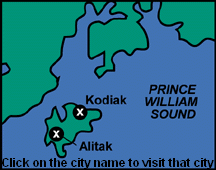Kodiak Alaska (Region 3)
Kodiak Island is a large land mass off Alaska’s southern coastline. At 100 miles long and 60 miles at its widest point, the island is the biggest in the Kodiak Archipelago and the second most sizable in the United States.
Despite its size, the mountainous landscape has just seven towns. Forests take up much of the north and east areas of the island, while the south-western portion is home to the Kodiak National Wildlife Refuge. That leaves little room for communities, which is just how the residents that live there like it. They welcome tourists, but are happy to lead a relatively quiet existence on their isolated island home.
The largest township, Kodiak, shares the island’s name. This fishing port is also a transport hub, as it’s home to the island’s only airport and ferry terminal. Travelers must bypass Kodiak on their way to the island’s other smaller communities, including Old Harbor, Port Lions, Larsen Bay, Akhiok, and Karluk.
Kodiak Island’s wildlife helped sustain its original Alutiiq inhabitants. These indigenous people hunted and fished for their food and farmed the land some 7,000 years before the arrival of Russian explorers in 1784. They settled near present-day Old Harbor and developed the island until the United States purchased it, along with the rest of Alaska, in 1867.
Many years have passed since its inception but Kodiak Island is still rich with wildlife today, including its native king crab and the famous Kodiak bear. While Kodiak’s creatures are often admired from a distance on wildlife cruises and bird watching tours, they are also prized by hunters and anglers.
Fishing is more than just sport for the people of Kodiak Island though; it is the island’s most profitable industry. Some summer work in the fishing sector is available, but as the industry focuses on bottom fish and crab, rather than the migrating salmon, opportunities are more limited than in other Alaskan regions. Seasonal travelers keen on spending time on Kodiak Island often find positions in local wilderness lodges, hotels, and canneries.
Kodiak Island’s marine-influenced weather is best described as fickle. The locals joke that if you aren’t happy with the conditions, you need only five minutes to see them change. However visitors can typically rely on temperate to cold weather and at least a little rain during their stay. Dressing in layers, ideally with a water-proof coat, is the best way to be prepared.
Kodiak Island is home to a handful of hotels, but bed and breakfasts are much more common. The most luxurious of these provide a piping hot breakfast each morning, while basic establishments offer the ingredients for guests to create their own morning meal. Wilderness lodges have some of Kodiak Island’s most opulent accommodation. Here guests enjoy outdoor activities, comfortable rooms, and warm personalized service. Long-term vacation rentals and the campgrounds at Fort Abercrombie and Buskin River State Parks are ideal for seasonal workers looking for inexpensive, extended accommodation.
It’s important to note that Kodiak Island has a modest range of accommodation options when compared to many Alaskan tourist regions, so travelers are advised to make their arrangements well in advance. It’s not uncommon for rooms to fill up weeks or even months before special events and school vacation periods.

